#radical chastity
Explore tagged Tumblr posts
Text

#feetish#feminization captions#feminism#sissifeminine#radical feminist safe#sissy for bbc#bbc faggot#bnwo humiliation#caged chastity#sissy dress
131 notes
·
View notes
Text
i feel like there is hope i see women all the time deciding that they’re done and becoming more radicalized (even if they won’t call themselves radfems), mens own behaviour is digging them into a deep and dark pit that soon enough they won’t be able to crawl out of anymore
Sexual assault & rapes spike during natural disasters,
+ 37% post katrina
93% SA victims in immediate aftermath of katrina were disaster victims, 93% women & girls
keep your daughters and pets close & stick with your sisters, stay armed
#radfem#radical feminism#terf#radical feminist safe#radblr#radical feminists do interact#radical feminist community#radfeminism#terfblr#it makes me happy when women say lets just force men to wear chastity belts like yesssss you’re getting itttt
298 notes
·
View notes
Text
I have issues with the hunters of artemis in pjo being anti-men and girls only. I understand being wary of the boys, because some of those girls came from times that didn’t exactly.. have men treating women correctly. However, the blatant anti-men attitude frustrates me because it turns one of the few goddesses know for her feminism into a radical feminist which isn’t the only kind of feminism and definitely does not represent it as a whole. I hate that so many people hear feminism and think of the small group of radicalists, immediately assuming women who want equal rights hate men.
Artemis was a safe haven for women, she’s heavily associated with one of the only female heroes out there (Atalanta) and she definitely would empower women but that doesn’t immediately mean she hates men… she just doesn’t want to sleep with them or have them see her naked body because it goes against her vows of chastity. It’s that simple.
If I got anything wrong, feel free to correct me but please be nice about it lmao.
#the hunters of artemis#artemis#greek mythology#pjo#artemis pjo#percy jackson and the olympians#hunters of artemis#pjo artemis#riordanverse#riordan universe#feminism#artemis goddess#pjato#pjoverse#rrverse#percy jackson and the titans curse#percy jackson#heroes of olympus#trials of apollo#hoo#pjo hoo toa
165 notes
·
View notes
Note
I apologize if I missed the answer to this before, but…why is Aries the way he is?
oh that is a loaded question /lh
aries has always been sort of. very jaded, even as a kid! he's very knowledge-focused and wants to know the truth of basically everything ever, very autonomy-focused and wants everyone to be able to make their own choices about their lives and their bodies, and thus living in the town where this is absolutely not the case has led them to be a very cold and spiteful person. he was incredibly protective of robin as a kid, while also inspiring her to be more brave herself, which led her to start out with much higher confidence than she has normally.
meeting sydney and becoming a temple initiate helped with his jadedness a little! he felt like he was helping people and that lightened his heart a touch. likewise, he put a lot of his attention on sydney's autonomy, trying to lead him into valuing himself and his own opinions more. however, the fact that he was STILL getting consistently molested and accosted even in the temple made him more jaded again, especially because no matter how many times he told jordan what was going on, it continued to happen.
going through the vigil and becoming a monk, however, is when a lot of his radical thinking began to come through. being shown that the town and its god were being ravaged by some unseen threat? realizing that people in and around the town were aiding this threat? it completely radicalized him and made him determined to purge the town of its corruption by his own hand, which means going into the sewers and wherever else tentacles appear and beating the shit out of them with his whip. from this point on, he began to view virgo as a dying animal, and it was his job to protect both it and the town.
this is ALSO when he starts to get more verbally violent with people when they try to molest him, or even when he just thinks they are, which is what gets him sent to the Hopital™️and into harper's office. and over the time he's spent learning about the corruption and examining it as closely as he does, he can just kind of tell that harper is INCREDIBLY fucked up.
however, harper also inspires some pity in aries, and thus, rather than outright trying to purge harper, he tries to purify him. and this goooooes poorly, because harper is basically the corruption version of the antichrist and purifying him is a nigh impossible task.
what happens instead is that aries ends up with a hyper-concentrated pocket of corruption in his mind, which he keeps quarantined via psychological compartmentalization. this is basically the only way he can continue on his purging way and also deal with the fact that part of his brain now wants nothing more than to let harper do whatever he wants to him :)
aries also had to go retrieve the spear for the temple, which meant joining zephyr's crew for a good while. this is the point at which the corrupted part of his brain gets a little more say, because he actually spends A LOT of time being bait while zephyr's crew ransacks boats, and so he both gets the thrill of being naked (plus chastity belt) in front of dozens of people, AND the thrill of beating the shit out of a bunch of perverts (this is also where he got his tan)
and thus, we come to where he is now! his next adventure is probably either beating the shit out of remy or being possessed by the wraith for a spell <3
#dear diary#asks#aries the ardent#dol#degrees of lewdity#dol pc#thank you for your interest!#i'm very excited for him to learn about the ivory wraith#i recently read through some spoilers and whoo BOY#long post
16 notes
·
View notes
Text
Historically, at the core of the modern conservative movement’s agenda have been its efforts to impose a particular family structure, one with a working father and dependent mother who plays the role of primary caregiver for her children. Through social and economic policies – namely, the erosion of the social safety net – conservatives aspired to make this patriarchal unit into the primary source of economic security and, in the process, sought to winnow the viable life and career paths available to women. They required the “protection” of the family, the right argued, which was one of the many reasons it opposed the Equal Rights Amendment that would have made men and women equal in the eyes of the law. The amendment, they insisted, would “strike at the heart” of what conservative activist Phyllis Schlafly in 1978 called “women’s family support rights.”
The right’s goals remain much the same today, but its hard-right faction has doubled down on their moral orthodoxy while rejecting many traditional conservative economic strategies. For this growing segment of the right, the primary problem facing the country is the supposed assault on what it sees as “traditional” American culture and family, led by the Democratic Party, the broader political left, feminists, LGBTQ+ people, and others who fail to fit their rigid views of gender. They want to impose, through the power of the state, stringent gender roles and social hierarchies, and to punish those who deviate from them.
...
Despite their exclusion from many of today’s most prominent hate groups, women are active participants in the hard right’s campaign to uphold male supremacy and create restrictive gender distinctions. One clear example is the so-called tradwife (or “traditional wife”) movement, which proclaims that women can achieve personal happiness and contribute to a healthier national culture by embracing subservience to men.
Women’s interest in the tradwife movement is, in some ways, a response to modern economic realities. The movement is “rooted in many young women’s sense of discontent with mainstream society and capitalist systems that – in the U.S., in any case – make balancing motherhood and work a near-impossible task, with virtually no childcare support, limited sick leave, and few protections for women who need time away from work for childcare or eldercare responsibilities,” Cynthia Miller-Idriss, a scholar of extremism and radicalization, has noted. Some women have responded by looking backward to a romanticized version of domesticity captured by the 1950s propaganda that forms the backbone of the tradwife aesthetic.
The tradwife movement exists largely online, led by influencers whose content depicts stylized domestic bliss – their homes, cooking, clothing and children – alongside captions that encourage chastity and, often, homeschooling, homesteading and fundamentalist Christianity. Tradwives present submission as freedom and a return to the natural order, before feminism deceived women into thinking they could achieve fulfillment outside family life and heterosexual relationships.
100 notes
·
View notes
Text
youtube
The Fascination and Terror of Medusa: A Journey into Greek Mythology (Roman version)
Introduction to the Legend of Medusa
Medusa is one of the most fascinating and terrifying figures in Greek mythology. Known as one of the three Gorgons, Medusa is the only mortal among her sisters, Stheno and Euryale. Her most notable representation is that of a woman with snakes in place of hair, capable of turning anyone who meets her gaze to stone. The legend of Medusa has spanned centuries, influencing art, literature, and popular culture.
According to mythology, Medusa was not always a monstrous creature. Originally, she was a beautiful young woman, a priestess in the temple of Athena. However, her beauty attracted the attention of Poseidon, the god of the sea, who seduced her in the sacred temple. This sacrilegious act aroused Athena's wrath, who, to punish Medusa, transformed her into a monster. Her snake hair and petrifying power are the result of this transformation, which forever altered her fate.
Medusa is a complex figure rich in symbolism. On one hand, she represents beauty and innocence corrupted by violence; on the other, she embodies female power and vengeance. Her image has inspired numerous works of art, from ancient Greek amphorae to Renaissance paintings, and modern cinematic interpretations. Medusa continues to evoke interest and fear, remaining one of the most enigmatic and powerful figures in Greek mythology. Her legend is a powerful tale of transformation, punishment, and ultimately, resilience.

The Origins of Medusa
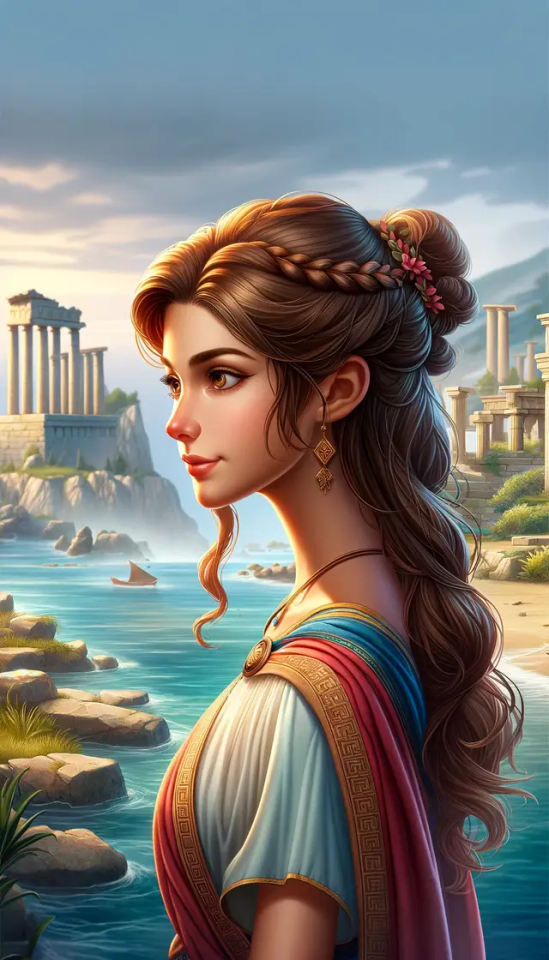
The origins of Medusa are deeply rooted in Greek mythology, where beauty and tragedy intertwine in a captivating and complex story. Initially, Medusa was not the monstrous creature everyone knows but a beautiful young woman known for her extraordinary beauty. She was one of the three Gorgons, daughters of the sea deities Phorcys and Ceto. Unlike her sisters Stheno and Euryale, who were immortal, Medusa was mortal.
Medusa became a priestess in the temple of Athena, the goddess of wisdom and war, requiring a vow of chastity and devotion. However, her life took a dramatic turn when Poseidon, irresistibly attracted by her beauty, seduced her in Athena's temple, an act of great sacrilege. Athena, furious at the desecration of her sanctuary, transformed Medusa into a monster. Her beautiful hair was turned into venomous snakes, and anyone who met her gaze would be immediately turned to stone. This radical transformation not only punished Medusa but isolated her from the world, making her a figure of terror.
Medusa's punishment can be interpreted in various ways. Some see Athena as a goddess who protected her temple and punished the violation of its sanctity. Others view the punishment as a symbol of divine anger and vengeance against corrupted innocence. Medusa's story reflects the complexities of relationships between mortals and gods, and the cruel irony of her fate continues to provoke discussions among scholars and mythology enthusiasts.
Despite her transformation into a monster, Medusa remains a tragic and captivating figure. Her story highlights universal themes of beauty, power, punishment, and redemption, making her one of the most intriguing figures in Greek mythology. Over the centuries, Medusa has become a powerful symbol, whose legend continues to inspire and frighten, representing an important chapter in the rich tapestry of Greek mythology.
The Transformation of Medusa: From Beautiful Priestess to Monster
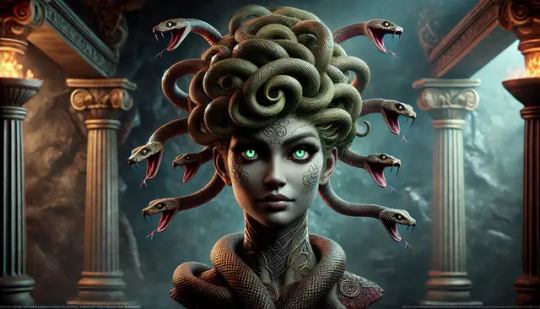
The transformation of Medusa from a beautiful priestess to a petrifying monster is one of the most famous metamorphoses in Greek mythology, laden with symbolic and moral meanings. Originally, Medusa was a beautiful young woman known for her extraordinary beauty. As a priestess of Athena, she was bound by a vow of chastity, devoutly serving the goddess of wisdom and war in her temple. Her life took a dramatic turn when she caught the attention of Poseidon, the god of the sea.
Poseidon, captivated by Medusa's beauty, seduced her in Athena's temple, a sacrilegious act that violated the sanctity of the place. Athena, enraged by the desecration of her temple, transformed Medusa into a monster, drastically altering her physical appearance and marking her future existence.
Medusa's metamorphosis was complete: her beautiful hair was turned into venomous snakes, and her gaze became so powerful that it could turn anyone to stone. This new aspect made Medusa a feared and isolated figure, relegated to the fringes of the known world. Her transformation is rich in symbolism: snakes, often associated with wisdom and rebirth, here become emblems of terror and death, while her petrifying gaze represents the paralyzing effect of fear.
This punishment can also be seen as a critique of female beauty and its perception in society. Medusa, once admired for her beauty, became a monster because of the very quality that made her special. The myth can be interpreted as a reflection on the fragility of beauty and its potential to provoke envy and destruction.
Despite her terrible transformation, Medusa remains a tragic figure, symbolizing corruptible beauty and the power of divine vengeance. Her story continues to be told and reinterpreted, an eternal reminder of the power of the Greek gods and the consequences of transgressions in their capricious and merciless world.
Medusa and Perseus: The Hero and the Monster
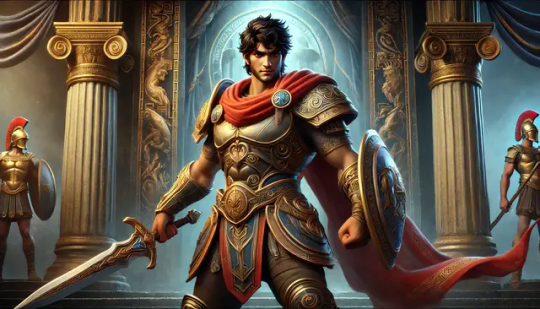
Medusa's story is inextricably linked with that of Perseus, one of the most famous heroes in Greek mythology. Their legend, rich in adventures and twists, tells of courage, cunning, and divine interventions, culminating in one of the most iconic battles between a hero and a monster.
Perseus was the son of Danae and Zeus, conceived under extraordinary circumstances. Danae had been imprisoned in a bronze tower by her father, Acrisius, king of Argos, due to a prophecy that foretold he would be killed by his grandson. However, Zeus, transforming into a shower of gold, reached Danae and made her the mother of Perseus. When Acrisius discovered his grandson's birth, he locked Danae and Perseus in a chest and cast them into the sea. The two survived and were taken in on the island of Seriphos.
Here, Perseus grew up to be a brave young man. His adventure began when the king of Seriphos, Polydectes, who was in love with Danae, sought to get rid of Perseus by sending him on an apparently impossible mission: to bring back the head of Medusa, the most fearsome of the Gorgons. Perseus accepted the challenge and received divine assistance for the task.
Athena and Hermes, the gods who protected heroes, provided Perseus with essential tools: a reflective shield, an adamantine sickle, winged sandals, a kibisis (a magical bag), and Hades' helm, which rendered him invisible. With these gifts, Perseus traveled to the land of the Gorgons.
Medusa lived with her sisters in a remote and inaccessible place. Perseus, using the reflective shield to avoid her petrifying gaze, approached Medusa while she slept and, with a precise stroke of the sickle, decapitated her. From Medusa's mortal wound sprang two extraordinary creatures: the winged horse Pegasus and the giant Chrysaor, symbols of beauty and power emerging from chaos and destruction.
Perseus not only succeeded in his mission but also used Medusa's head as a weapon, exploiting its petrifying power on numerous occasions. Eventually, he gave the head to Athena, who placed it on her shield, the aegis, as a symbol of protection and terror.
The story of Perseus and Medusa is rich in symbolic meanings. Perseus represents the archetypal hero, capable of overcoming impossible challenges through courage, cunning, and divine help. Medusa, on the other hand, embodies terror and corrupted beauty, a creature who, despite being a victim, becomes an instrument of destruction.
This legend continues to be an inexhaustible source of inspiration in culture, art, and literature, reminding us of the complex dynamics between heroes, monsters, and gods in the fascinating world of Greek mythology.

Symbolic Interpretations of Medusa
Medusa is a character steeped in symbolism, with interpretations varying over time and cultures. In Greek mythology, she represents divine punishment and the transformation from beauty to monstrosity, a reflection on the fragility of beauty and the destructive power of divinity. Her ability to petrify with her gaze can be seen as a metaphor for the paralyzing power of fear and terror. In psychological terms, Medusa can be interpreted as a symbol of repressed female power and vengeance. Carl Jung, the Swiss psychologist, saw Medusa as an archetype of the "terrifying mother" and female destructive power. In contemporary culture, Medusa is often revisited as an emblem of resilience and female strength, an icon of empowerment challenging traditional gender roles.
Medusa's Influence in Popular Culture
Medusa's influence in popular culture is vast and enduring, spanning literature, art, cinema, and fashion. In literature, she has appeared in works by authors such as Ovid and Dante, continuing to inspire contemporary writers. In art, her image has been immortalized by artists like Caravaggio and Rubens. Cinema and television have repeatedly revisited the myth of Medusa, with interpretations ranging from epic films like "Clash of the Titans" to TV series and video games. Fashion has adopted Medusa's iconography, with the brand Versace using her head as its logo, symbolizing beauty, power, and mystery. Medusa continues to be a powerful cultural symbol, capable of evoking strong emotions and stimulating deep reflections on human nature and society.
#athena#cultural influence#Gorgons#Greek Mythology#medusa#Perseus#Poseidon#symbolism#mythology#youtube#digital art#fantasy#videos#folklore#mythical creatures#Youtube
8 notes
·
View notes
Text
I think we should keep something in mind this Christmas/holiday season. As the Christian narrative floats around, the white swaddled newborn plastered on billboards, and the focus on what's "sacred" and "holy" circulating through churches around the western world...
The body being "sacred" has nothing to do with some fucked white European idea of chastity or purity. It has absolutely EVERYTHING to do with making sure people are able to feed themselves and their children, not be straight up poisoned by pollutants, or fetishized and exploited for profit. Holiness has nothing to do with being clean or looking your Sunday best.
It was never actually about "purity" or "virginity" or "cleanliness". If it was, why the hell would Jesus have been crucified? The real historical dude said stuff that pissed off people in power so much they fucking merked him. Nothing pisses off agrarian feudal lords or modern capitalists more than telling the masses that they aren't simply morally justified, but on the side of GOD when they steal medicine and food for their children. If you don't believe me, I highly recommend reading William Herzog's "Parables as subversive speech", read about what theologians actually think historical Jesus was talking about all those years ago. Whether you believe in God or not, think religion is a plague or pray a rosary every night, I think keeping this in mind is like super important.
Christianity becomes dangerous and, in the opinion of this demon girl, blasphemous when it is removed from the context of its social cause, when it's co-opted by those in power and disarmed of the radical rhetoric that it was born from originally. I think that's exactly what we see in broader society. I think that an entirely rational response to this is to equate all of Christianity or even all of religion with evil... But I think there's nuance here.
To be clear, I stand with the satanists who support the fight for separation in church and state by chastising the corrupt institutions who have become the opposite of what they claim to espouse. I stand with the atheists who keep the naive theologians in check, and offer peace to the people who have been ravaged by the monster modern Christianity is to so many. Don't stop doing what you're doing. If Jesus was standing here today he'd be standing with you. You're fighting modern day pherisees out here and I'm for it.
Now, this is not to say there aren't problematic things that were always present in the Christian religion, of course there are. And they're quite abundant. I think Christians need to be very aware of that as well. There's nuance there. What I'm calling for here is a realization that the religion of the oppressed is not the same as the religion of the oppressor, and that the religion of the oppressed, when not stripped of its merit and co-opted by systems of greed, can be a force for good. And when we use that lens to look at this bizarre spectacle we call "Christmas", we can learn some interesting stuff.
What I'm saying is, if you're trans, gay, whatever, for the love of God, literally, please LIVE. Listen to your friendly demon izalith. By existing as who you are, you are sacred. Don't let the people wearing robes and claiming to be on the sides of angels and "God" tell you who you can or can't love, or what you can or can't be. If there is a God out there, and he's with those punks, then he's no god. I spit on his name. Angels are overrated anyways... It's the demons, the poor person who steals from Walmart to feed themselves and their children, the prostitute who is proud of their job and the life they work hard to sustain, the fat trans person who goes to Christmas mass in goth makeup... It's those people who the religion was originally made for. It wasn't made for the rich, the white, the straight, the normative. It was made for us. For all those people who are downtrodden, cold this winter, unable to buy food, scared and tired. Fuck that shit they used to traumatize us and belittle us when growing up. It's all lies and venom anyways. If no one loves and accepts you, this demon will.
#christianity#counter-culture Christian#some demon theology#blasphemy is kewl#jesus would scoff at whatever the hell y'all been calling Christianity. especially if we're basing that off the greek orthodox jesus#queer theology#liberation theology#religious commentary#religious trauma#trans#Christmas#tw: religon
16 notes
·
View notes
Text
I have a thought about shaming western feminist for "not being able to live with men" "having sex with men" being weak links to feminism and bringing up us as an example butttt this is tone-deaf and lacks nuance, thought it through but like we had celibacy and chastity before marriage driiilled to our brains, when korean women were opting separatism it wasn't a political choice but mostly a personal choice( economy developed enough for women to live independently and have consciousness and demand more from their high rates of higher education- even more than men, but society not developed enough to make them feel as equal) but also even for it's brand of said radical feminists^ - which don't subscribe to politics like Tumblr etc does, a lot of women and girls were already celibate and raised in purity culture. A lot already had qualms and guilt etc about casual sex with men. You can't make women give up what they didn't do before and It makes the choice or non choice easier. To apply it the same way for different cultures which might be more liberal feminist free love etc branded misogyny- honestly it's not a cut out win or lose. y'all can cut some slack
8 notes
·
View notes
Text


DISGRACED POLITICIAN'S DAUGHTER MARRIES HATE PREACHER'S SON
Newcrest
Conservative politician David Johnson, 51, made headlines fifteen years ago when he was exposed for his adulterous affair with Henrietta Jones, 50, and lost his position as a conservative spokesperson during the ensuing scandal. The disgraced politician who now holds communal office in Newcrest and also pastors an independent home church there has stayed out of the spotlight and quietly remarried after his tragic wife's death (thought by many to be brought on by his shameful actions), but now he is once again courting notoriety. His oldest daughter by his late wife has found love with the oldest son of radical hate preacher Maxwell Sawyer, who also resides in Newcrest and attends Johnson's church.
Maxwell Sawyer Sr. continuously draws liberal ire with his controversial blog posts about topics such as chastity, abortion, corporal punishment and spousal obedience, but his books like "Why Husbands Fear the Watcher" and "Why Wives Submit" have been received warmly by religious and conservative circles. "I just say what everyone thinks, but is too scared to say in this politically correct climate," Sawyer, 42, who recently welcomed his seventh child with his wife Theresa, claimed when approached by our reporters after the wedding ceremony.
Priscilla Johnson and Maxwell Sawyer Jr., both turned 18 just a few weeks ago, were recently married after a chaste courtship by the bride's father David Johnson. When asked if 18 is not too young for a lifelong commitment like marriage, the bride replied, "Of course not! We're both of legal age, and we think it's so important to build a future as a couple together when we're still young enough to enjoy it! Maxwell wants to follow into my dad's political footsteps, and I'm so proud that he's chosen such a noble occupation for himself, and honored that he has chosen me to be at his side!"
(@clarkes-and-god Thank you so much for the banner!)
#johnsonfamily#david and abilene#sawyerfamily#maxwell and theresa#maxwell jr and priscilla#a new newcrest#gen 2#spring3#fundie sims#fundie simblr#ts4 fundie#sims 4 fundie#sims 4 legacy#quiverfull sims#new newcrest news
16 notes
·
View notes
Text

These fine men are the newly elected Board of Directors in West Rockford, Virginia. The men all ran on a shared platform of conservative values, traditional masculinity, and of course Overalls for All. They ran against the incumbent liberal board, whose woke policies had caused all sorts of problems in the old mining town. The new Board ran on a promise to return West Rockford to its golden years where men were men and traditions were honored.
Now in power, the Board enacted a number of sweeping changes to get their town back on track. First was the Overalls for All Act, which requires men of all ages to wear overalls every single day. Men caught without overalls would be arrested and required to attend re-education courses taught by the Board themselves. On Sundays men all must wear a white shirt and red tie under their American-made Roundhouse overalls, generously donated by the company itself after the Board convinced them to open an overalls factory in West Rockford. This generated a number of new manual labor jobs for men, reducing male unemployment while also stimulating the economy.
Local schools were given extra funding for wood-shop and auto-tech classes, under the prerequisite that theses classes be mandatory for male students while also banning woke ideology like gender studies and critical race theory in schools. The Pledge of Allegiance was also made mandatory. The Board expects legal challenges to this, but they are confident the conservative majority Supreme Court will rule in the favor of patriotism. The Board views the education of the next generation of men paramount to enshrining the town's new conservative agenda.
Public behavior laws were also put into effect. In addition to the mandatory uniform overalls, men are also expected to refrain from profanity and lewd comments. Men are expected to comport themselves like good Christian men, attending church daily in clean overalls, and refraining from sinful acts like masturbation. The Board encourages chastity cages for all male citizens, even considering making them mandatory in the future. In addition, fathers are required to read to their sons from the Bible every evening to instill traditional values.
After just a few months, the new Board's policies were proving successful. Despite pushback from radical liberal activists, the data was proof that Overalls for All was a positive change. Truancy and unemployment was down, while church attendance and income were up. A poll even reported that more men felt a stronger sense of purpose and community. Many former liberals had to admit that their overalls helped them realize the importance of traditional masculinity.
The Overalls for All Movement was thriving outside of West Rockford too. Towns across the nation embraced the conservative movement. Town boards and councils in every state were advancing the overalls agenda, with many overalls-wearing board members running for state government as well. The Board of Directors in West Rockford took this as permission to pass even stricter overalls laws in their next session.
America has a bright future in overalls. Overalls for All!
4 notes
·
View notes
Text
Potentially Problematic Genealogy of #cottage core (Entry 03)
Where can religion, queerness, feminism, purity culture, and other fandoms lead on Tumblr?
My research so far causes me to feel like I need a conspiracy board to explain. This is because if you start somewhere innocuous, such as exploring queerness and seeking resources or community for one’s queer identity, as many youth come to Tumblr to do (McCracken 156), you will likely start with relevant tags such as #queer, #LGBTQ+, #gay, #lesbian, and #transgender. As was already explored with the intersections between transgender related tags and TERFs, the #lesbian tag will also quickly lead to TERFism, especially with the anti-trans appropriation of the labyrs symbol/flag, as seen in the two posts below where #lesbian and #radfem are directly correlated.


Searching for most LGBTQ+ content will also lead to the aesthetics of such, be it pride flags, educational blogs, or art; but for the purposes of this research the connection to the #cottage core aesthetic is the most noteworthy because #cottage core is a nexus of intersections with religion, queerness, feminism, and purity culture. “Cottage core” is characterized as pastel colors and an idealized European-esque rural/country life.
The first branch of #cottage core will lead to the 1950s aesthetic, then #trad wives and traditional gender roles, then Christianity and biblical womanhood; then you have returned to the very purity culture someone may have been trying to get away from. Refer to the following four posts.

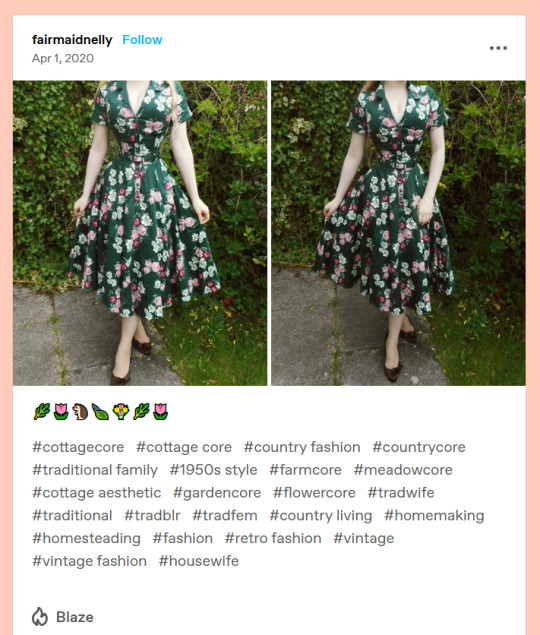

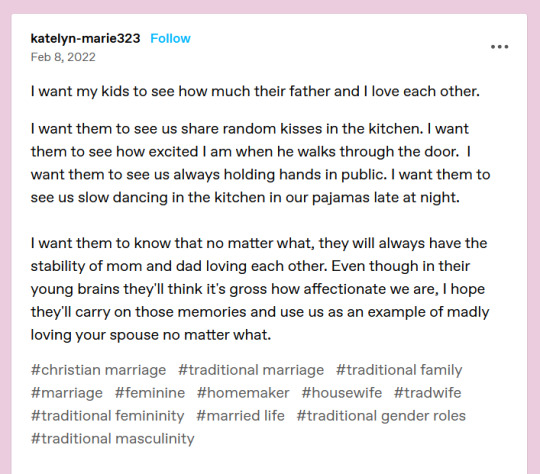
The Christian purity culture side is often accompanied by posts containing anti-Satanic rhetoric or general sentiments against other religions, anti-queerness, and support for chastity and repressed sexuality. Unfortunately, due to the nature of Tumblr, finding posts can sometimes be difficult with certain topics and this is one of them. The particular intersection between Christian traditional life posts and anti-Satanism and disdain for non-Christians is documented by STRANGE ÆONS and has also been anecdotally observed by myself.
The connection #cottage core has with traditional gender roles can lead back to feminist discourses resisting those traditional views and purity culture, but can also lead to the anti-feminist and Women Against Feminism sides of Tumblr which will be evaluated in several instances later. Moving from traditional gender roles you will see posts contrasting the “liberated feminist” (negative) with the “traditional wife” (positive), then to the Trad Girl memes and Men Going Their Own Way, both of which will intersect with Nazism/white supremacy as the Trad Girl meme has racist connotations and Men Going Their Own Way view white women as “corrupted” by feminism thusly requiring them to exclusively seek out non-white women for sexual/romantic conquest, then these tags will move to Christian nationalism, and back once again to purity culture. This genealogy is documented in the eight posts below.
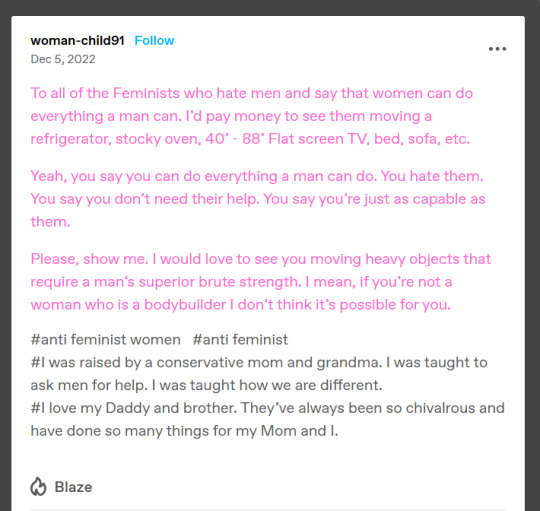

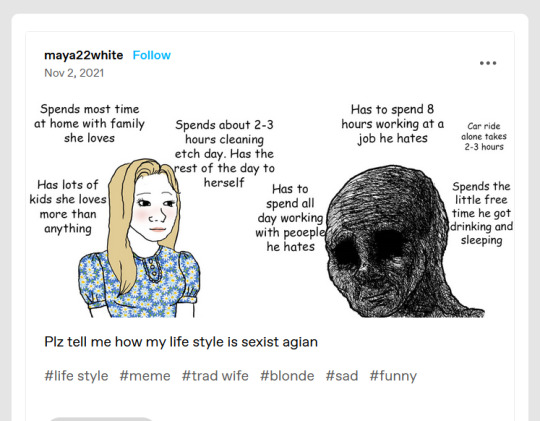
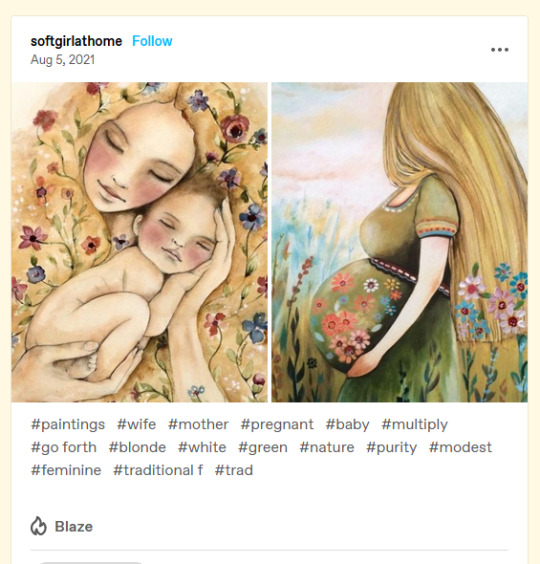
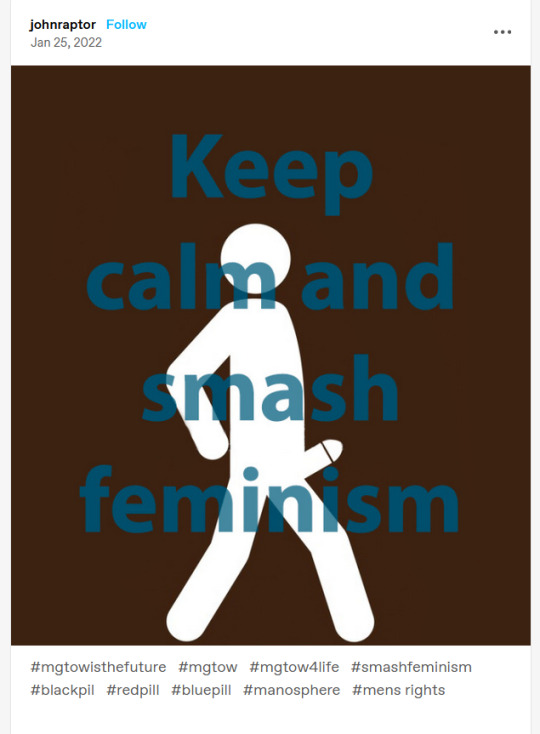
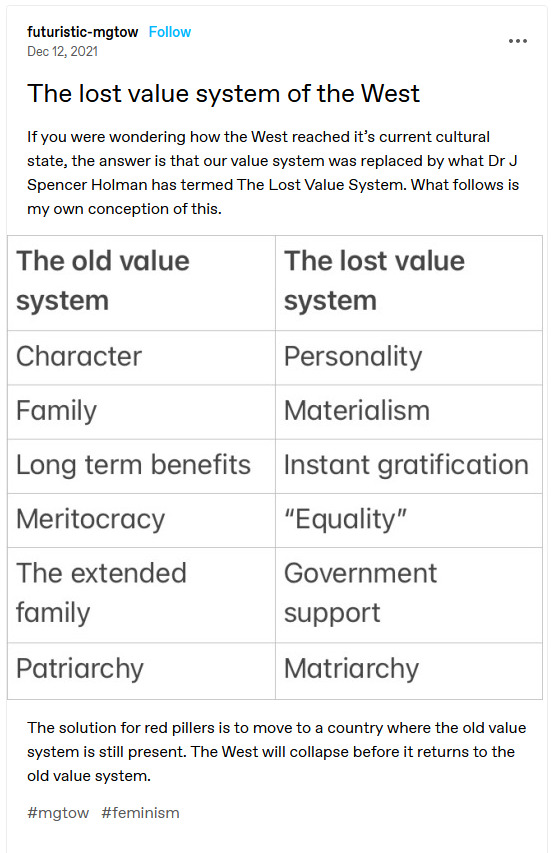

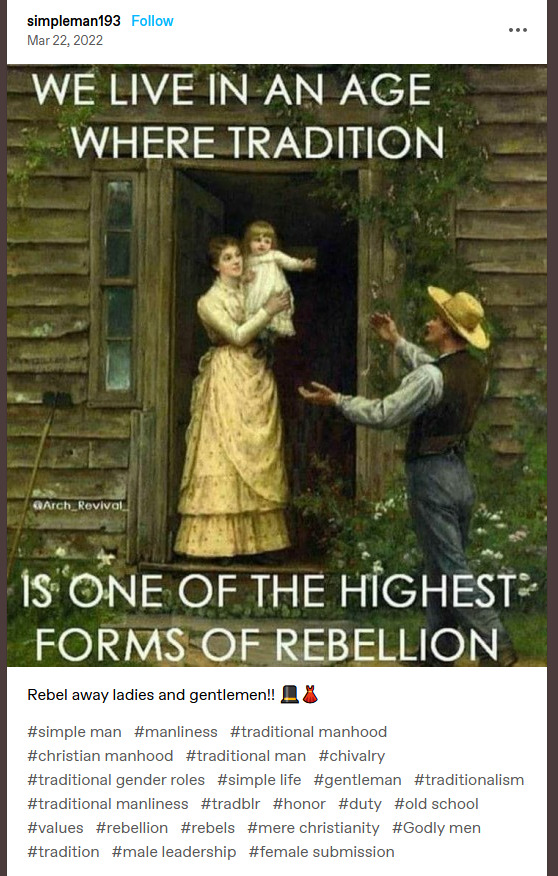
Additionally, #cottage core breaks off to become radical anti-capitalist escapism, then queer discourses mostly centered on subverting Christian influence; that leads to neopagan/witchcraft and/or Satanism. Both of these will loop back around to Christian purity culture and biblical womanhood through those fandoms’ anti-Satanist/non-Christian perspectives. This pipeline is witnessed in the next seven posts below.
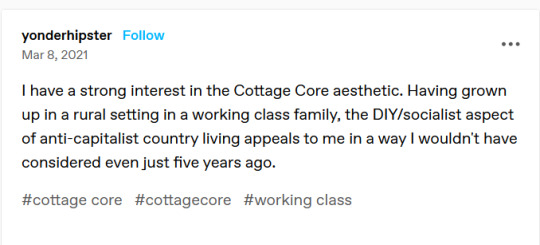


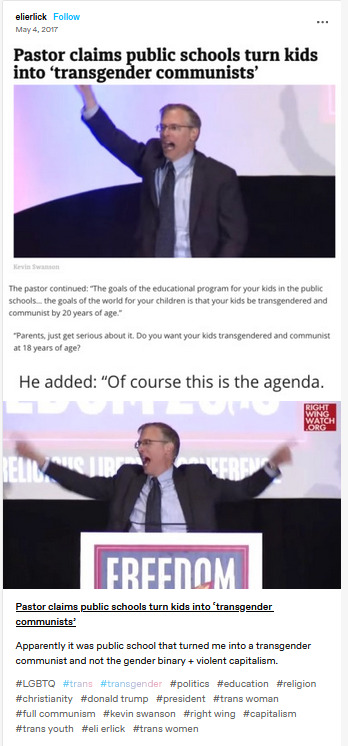
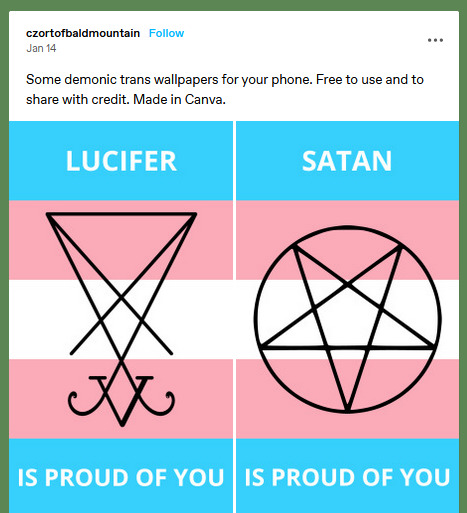


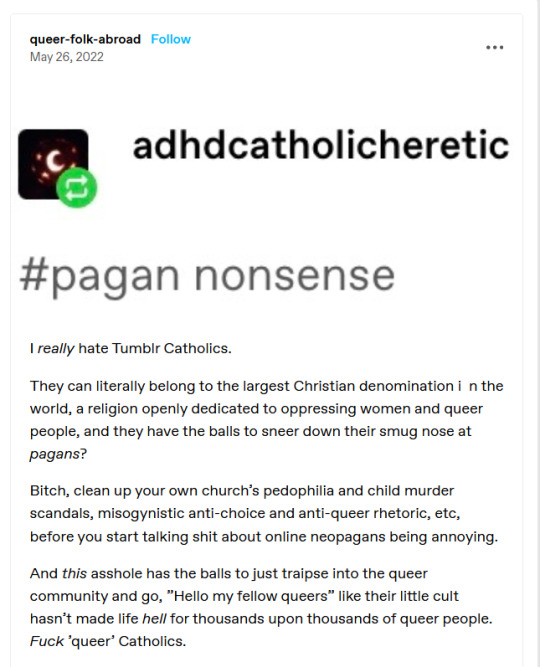
However, as much as the previous pipeline through queerness to neopaganism/witchcraft seems to be a more liberative pipeline someone can stumble into to get away from oppression and find queer solidarity, there is a noteworthy divergence. Neopagan/witchcraft can branch off to the #goblincore aesthetic which will return through queerness, anti-capitalist escapism, and back to #cottage core; but the other branch will lead to the Nazi/white supremacist sides of neopaganism, then back to Men Going Their Own Way, which can then become Christian Nationalism, traditional gender roles, and once more back to purity culture and biblical womanhood. Fortunately Tumblr’s current content moderation policies seem to have made it difficult to show explicitly Nazi/white supremacist connections to neopaganism, but here is an article from the University of Alberta discussing this, and here is one from The Atlantic. Moreover, the Asatru Folk Assembly (often abbreviated on Tumblr as AFA) is a notorious Nazi/white supremacist religious organization based out of California; this is similar to the Odinic Rite though their home location is unknown. Both groups use the Nine Noble Virtues, the “Black Sun” sigil, and reference Asatru as dog whistles and to provide subtle covers for their ingrained bigotry and origins in the German Nazi Party. Other Nazi/white supremacist neopagans/witches unaffiliated with Asatru Folk Assembly or Odinic Rite will also use the Black Sun, Nine Noble Virtues, and/or Asatru as ways to signal each other both in-person and online. Below is an example of a post/blog that is clearly aligned with neopagan/witchy Nazi/white supremacist ideologies and below that is a call-out post/meme attempting to educate others about the Black Sun and connections to Asatru. The latter post serves as a great example of additional important discourse also being added in the tags.

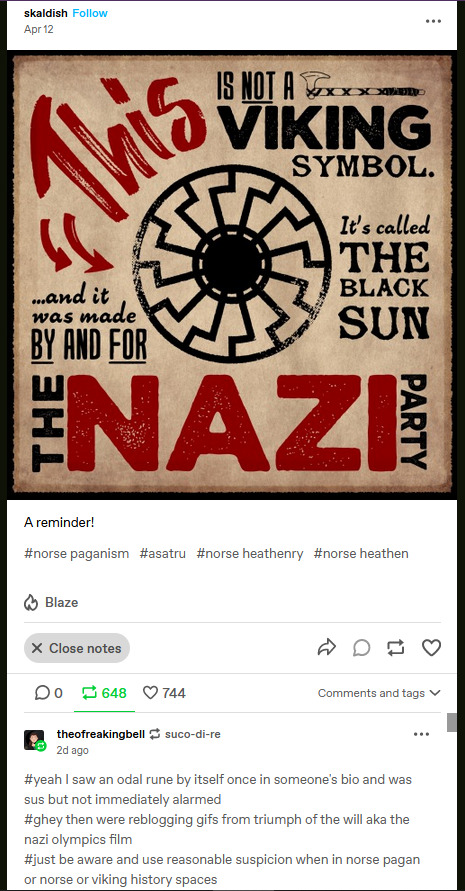
The last genealogy for now is #cottage core, to the #coquette aesthetic. #coquette is characterized by hyper femme, young/teen girlish aesthetics, and often contains overtly Christian imagery with crosses, crucifixes, angels, and commentary rejecting the religion (usually found in the tags). Interestingly, #coquette tends to lead in two different directions which both return to Christian purity culture. The first pipeline – shared in-part in the three posts below but which I will not be completing for obvious reasons – goes from #coquette, to #loli and related kink tags like #dd/lg (Daddy Dom, Little Girl), which then lead to pedophile/Minor Attracted Person (MAP) discourses, those then intersect with both Men Going Their Own Way and traditional womanhood/gender roles as pedos/MAPs want girls before they are “corrupted” by feminism, then you have practically returned to Christian purity culture.
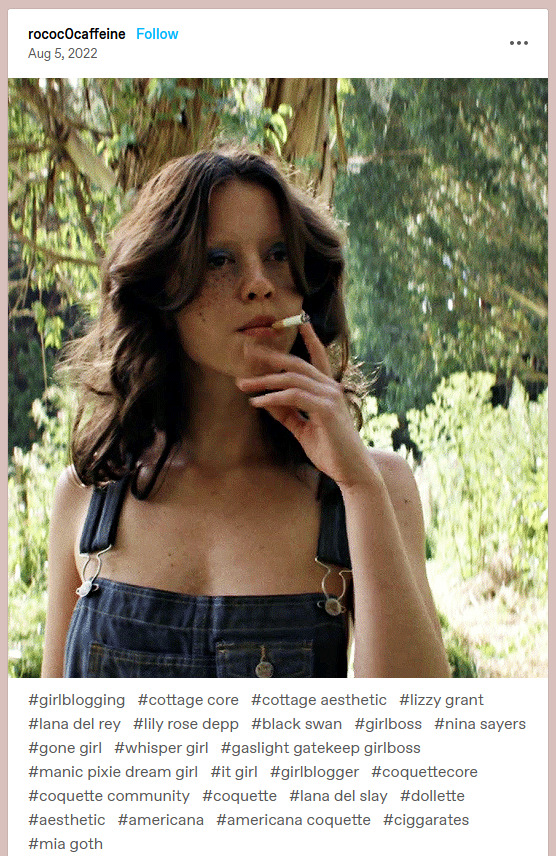


The second pipeline, seen in the next two posts, starts at the intersection of #coquette with #divine femininity, then that can either lead back to the queer and neopagan/witchcraft pipeline; or back to the #lesbian, to #RadFem/#gender critical/#TERF, then to those groups’ supposedly resisting conservative gender roles but actually creating their own “anti-trans purity culture of ‘womanhood.’” Considering gender criticals and “gender ideology” originates with anti-feminist right-right Christians and was heavily disseminated by the Catholic Church who claimed gender egalitarianism, sexual liberation, and LGBTQ+ issues were all an attack on family values (Pearce 681), are these TERFs and trans-exclusionary lesbians actually as far removed from Christian purity culture as some of their posts would indicate?
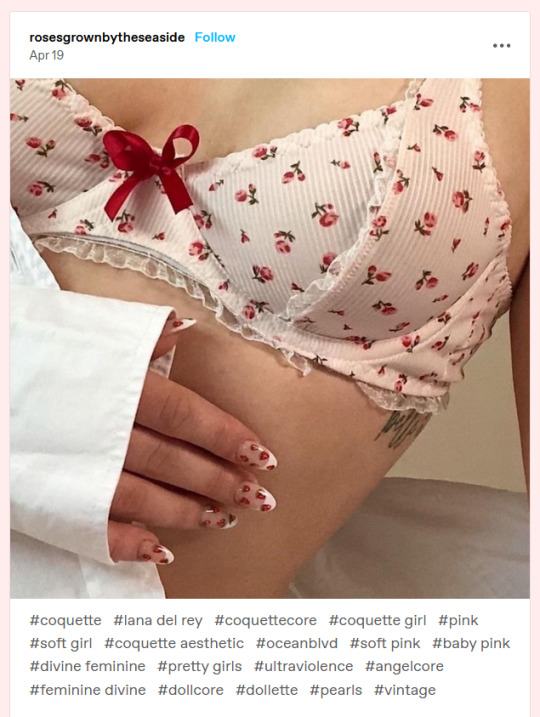
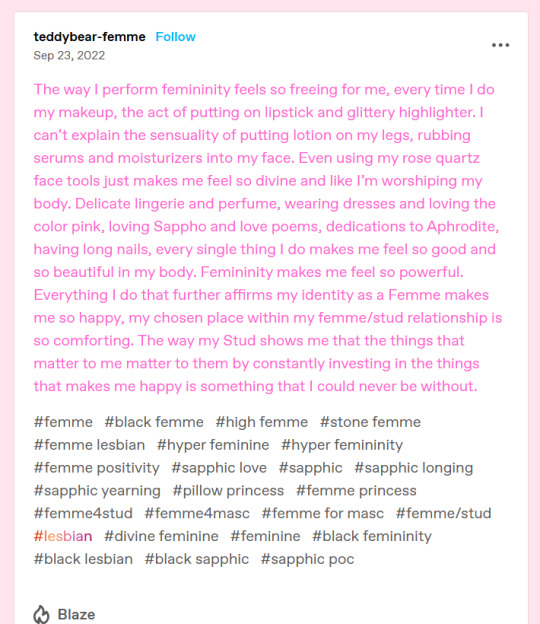
Being able to perfectly screen capture the full genealogies of Tumblr posts centering on queerness, feminism, religion, and purity culture (or any topic) is not always possible due to the mysterious nature of the platform’s algorithm. Sometimes there are posts with no tags which clearly state something related to the tags for which you searched, posts can get removed by the creators or content moderation, and the posts under popular tags like #lgbtq, #Christian, or #cottage core will substantially change every day. Since factors like follower count, verified accounts for celebrities/public figures, or artificially boosted posts are not part of the algorithm none of them are directly related to how popular a post becomes, resulting in anyone suddenly gaining unforeseen engagement for a random post they made recently or in the past. However, the amount of interaction you want on Tumblr can often be finely tweaked using tags to increase or decrease one’s chances of being noticed. Additionally, the built in privacy and anonymity of the platform, combined with these other factors, results in Tumblr being referred to as a black hole, considering you can never be certain what or whom you will find and causing it to be different to navigate (though many sources will claim “difficult”) (Cavalcante 1715-1716; Keller 8). Considering all these factors, Tumblr genealogies are best discovered organically as one routinely engages on the platform over long periods of time, thereby making it hard to perfectly record the numerous interactions retroactively or quickly.
Due to this black hole nature of Tumblr, queer youth seeking to find support can seemingly end up in problematic fandoms or back to the very purity culture and religious oppression they came to the site to escape. But is this really a problem of Tumblr’s? As discussed in Entry 01, the transgender technology of Tumblr enables forms of expression no other social media site can, which is absolutely necessary for communal grassroots discourses, solidarity, and activism for queer, BIPOC, disabled, and feminist perspectives. This “meaningful diversity” is powerful and appealing to much of the existing userbase and to the marginalized youth and young adults who continue to come to Tumblr for that very diversity while figuring themselves out (McCracken 158-159). Thusly, I suspect that demanding or somehow legally requiring the platform make changes reducing the pipelines to problematic fandoms cannot be done without impacting the “transness” and meaningful diversity of Tumblr. Plus, unintentionally encountering or being sucked into harmful communities in the real world and on other social media sites are already risks. What then can be done to mitigate people falling too far down the wrong side of this black hole or help people avoid and resist oppression in other aspects of life?
Works Cited:
Cavalcante, Andre. “Tumbling Into Queer Utopias and Vortexes: Experiences of LGBTQ Social Media Users on Tumblr.” Journal of Homosexuality 66, no. 12 (2019): 1715–1735.
Keller, Jessalynn. “‘Oh, She’s a Tumblr Feminist’: Exploring the Platform Vernacular of Girls’ Social Media Feminisms.” Social media + Society 5, no. 3 (2019): 60-77
McCracken, Allison. “Tumblr Youth Subcultures and Media Engagement.” Cinema Journal 57, no. 1 (2017): 151-161.
Pearce, Ruth, Sonja Erikainen, and Ben Vincent. “TERF Wars: An Introduction.” The Sociological Review (Keele) 68, no. 4 (2020): 677-698.
STRANGE ÆONS, “Learning How To Be A Traditional Wife | Tumblr Deep Dive” (https://www.youtube.com/watch?v=i7OjkudXSe0&t=4s).
5 notes
·
View notes
Text
Everything was at stake in a country where the judiciary now does little more than rubber-stamp policy dictated by the president. It would be an understatement to say that for rights defenders, five more years under Erdoğan is a daunting prospect. Women’s and LGBTQ+ rights groups especially will find themselves in the immediate line of fire. During his first victory speech in Istanbul last night, Erdoğan targeted LGBTQ+ groups again. “Could those LGBT elements ever find their way into the AK party?” he asked to a resounding “no” from the crowd. “Family is holy to us,” he continued.
Ahead of the runoff elections, the women’s rights group Left Feminist Movement warned that the choice between Erdoğan and Kılıçdaroğlu was one between “darkness” and “light”. A statement signed by several dozen well-known female musicians, actors, writers and rights defenders said: ��We either succeed in tearing apart the darkness and glimpse the light of dawn, or we will suffocate.”
Many have argued that Turkey has never had a more ultra-conservative and misogynistic parliament than it does now. Two radical Islamist fringe parties have joined the national assembly on Erdoğan’s side. His AKP has not only brought the New Welfare party (YRP) into its alliance, but also nominated four senior members of the Kurdish Free Cause party (Hüda-Par) under its parliamentary candidate list. All four were elected to parliament on 14 May. The Free Cause party is closely affiliated with Kurdish Hezbollah, a Sunni militant group that originated in the Turkish south-east and gained notoriety in the 1990s when its members tortured and killed hundreds of Kurdistan Workers’ party (PKK) members and supporters, as well as others who opposed its ideology, though it has since officially renounced violence. Free Cause calls for gender segregation in schools and has argued that state services for women, such as healthcare or education, should only be rendered by female employees.
Meanwhile, in the New Welfare party’s manifesto, it demands that “morals, chastity, mercy, devotion and productivity” should be strengthened among women through female “role models”. Both parties have aggressively lobbied against LGBTQ+ rights, targeting them as “perversion”, as well as for the criminalisation of adultery. They have also vowed to scrap law 6284, introduced by the AKP government in 2012, which aims to prevent violence against women. Women’s rights activists have accused them of aiming for “Taliban-style” rule.
Despite almost unfettered presidential powers, Erdoğan may need the support of these parties to push through legislative changes in parliament. Their presence further normalises discriminatory attitudes, already rampant among the governing bloc, towards women and LGBTQ+ people both inside and outside state politics.
The dangers facing women and LGBTQ+ people in Turkey have already increased in recent years. Femicide and gender-based violence are on the rise. Erdoğan compared abortions to murder in 2012, and although he failed to introduce a law that would have banned abortions after six weeks of pregnancy, women across Turkey still struggle to access safe terminations. Women’s rights groups speak of a “de facto abortion ban”. Women’s Day marches have increasingly been met with police violence and the Istanbul Pride parade has been banned since 2015. Feminist and women’s rights groups have been increasingly sidelined. Many civil society organisations fighting against discrimination and gender-based violence have been shut down since the 2016 military coup attempt.
In 2021, Erdoğan unilaterally withdrew Turkey from the Istanbul convention, an international treaty to fight gender-based discrimination and violence. Women’s rights groups reported that police officers had refused to assist victims of domestic violence, citing the withdrawal from the convention.
Last year, bogus charges of “acting against morality” were brought against We Will Stop Femicide, a feminist platform that fights gender-based violence and keeps a monthly count of murdered women. If found guilty, the group will be shut down. The next hearing will take place on 13 September.
On Sunday night, rights activists took to social media to declare that the election results should not deter people from fighting. “Our hopes should not be broken, but we need to be aware of the consequences,” tweeted Fidan Ataselim, general secretary of the We Will Stop Femicide platform. “We have no other choice than to keep organising, to give voice to reason and to stick together.”
At the same time, political leaders around the world rushed to congratulate Erdoğan on his election win. EU politicians are perhaps a little too relieved that the Turkish president, who has been a willing partner in their project to keep refugees out of EU states, will remain in power. . For them, Kati Piri, a Dutch MP and former Turkey EU rapporteur, had one question: “What’s your message to the 25 million people who voted for restoration of democracy and rule of law?”
4 notes
·
View notes
Text
𓄂SOVERE𓋹GN Energy🌹
APHRODITE Urania (Celestial) and APHRODITE Pandemos (Earthly) 🌹
Aphrodite Urania (Ancient Greek: Ἀφροδίτη Οὐρανία, romanized: Aphrodítē Ouranía) was an epithet of the Greek goddess Aphrodite, signifying "heavenly" or "spiritual", to distinguish her from her more earthly aspect of Aphrodite Pandemos, "Aphrodite for all the people"
The two were used (mostly in literature) to differentiate the more "celestial" love of body and soul from purely physical lust.
Plato represented her as a daughter of the Greek god Uranus, conceived and born without a mother
According to Hesiod, she was born from the severed genitals of Uranus and emerged from the sea foam.
Aphrodite Pandemos was originally an extension of the idea of the goddess Aphrodite to family and city life to include the whole people, the political community.
Aphrodite Pandemos was held in equal regard with Urania; she was called σεμνή semnē (holy), and was served by priestesses upon whom strict chastity was enjoined.
In time, however, the meaning of the term underwent a change, probably due to the philosophers and moralists, by whom a radical distinction was drawn between Aphrodite Urania and Pandemos.
🌹According to Plato, there are two Aphrodites, "the elder, having no mother, who is called the heavenly Aphrodite [Urania] — she is the daughter of Uranus; the younger, who is the daughter of Zeus and Dione — her we call 'common' [Pandemos]." 🌹
The same distinction is found in Xenophon although the author is doubtful whether there are two goddesses, or whether Urania and Pandemos are two names for the same goddess, just as Zeus, although one and the same, has many titles; but in any case, he says, the ritual of Urania is "purer, more serious", than that of Pandemos
The same idea is expressed in the statement that after Solon's time courtesans were put under the protection of Aphrodite Pandemos. But there is no doubt that the cult of Aphrodite was on the whole as "pure" as that of any other divinities, and although a distinction may have existed in later times between the goddess of legal marriage and the goddess of free love, the titles Urania and Pandemos do not express that idea
~ Wikipedia ✨💎
2 notes
·
View notes
Text
I used to teach in a Catholic school, and I based my abstinence/sex education on Theology of the Body: the GOODNESS of sexuality, the TRUTH about human sexuality and human persons (the first made for procreation, the second for love and self-giving not just in the marital sense, but in all circumstances), and the BEAUTY of God's plan for sexuality. I taught my students the radical freedom of CHOOSING to follow the goodness of chastity: treasuring their sexuality so much that they abstain from sexual activity until they are in a stable, permanent relationship (marriage).
This is essentially how my non-religious parents raised us (without the understanding of the connection to God, just of the common sense goodness of wholesome sexuality). This is how we raised our four children, who all share this view of sexuality into adulthood.
Abstinence education MUST be based on a foundation of respect for self and others, and a sense of responsibility towards sex and how it can affect you and others. It can NOT be based on fear of sex, making sex an activity that “dirties” you, or something that turns virginity into a prize that makes you “pure.”
2K notes
·
View notes
Text
hey! you can call me either angel or astro. i'm a bisexual trans guy in my mid 20s. my pronouns are he/they irl, but you can use she/it on me too, it makes me feel dumb and wet🤍
a quick disclaimer; i've known that i'm trans for a majority of my life and have been on hormones for almost a decade. this blog is run by someone who is very inclusionist and above all else believes in radical love towards the queer and trans community. however, this is my space where i get to pretend otherwise ^_^ just know that everything you see on this blog is fantasy!
i'm a therian puppyboy (sometimes kittyboy!) who loves to get stoned all day and touch his tdick, sometimes while daydreaming about getting it locked away🤍
this blog will contain kinks such as: bdsm, cnc, misgendering, detrans, transphobia, slurs, forced fem, humiliation, degradation, breeding, lactation, intox, somno, getting cockdrunk, worship, hypnosis, conditioning, intelligence loss/shaming, body and weight shaming, hatefucking, chastity, cucking, denial, desperation... and more!!!
this blog is under construction! as of right now, i'm mostly just using it to reblog/like posts.
i highly encourage dms, but please make sure to be mean :3 i might be a pretty puppy, but i'm not meant to be taken home and cherished... i'm more like a pathetic thing that you should kick when you find it crying on the side of the road<3
more to be added later!
1 note
·
View note
Text

blogovision2024 50-100
50. NewDad - "Madra" (48) 51. Friko - "Where We've Been, Where We Go From Here" (47) 52. Colin Stetson - "The Love It Took To Leave You" (46) 53. Angry Blackmen - "The Legend Of ABM" (46) 54. Paul Weller - "66" (46) 55. St. Vincent - "All Born Screaming" (45) 56. Little Simz - "Drop 7" (44) 57. Tapir! - "The Pilgrim, Their God And The King Of My Decrepit Mountain" (44) 58. Arooj Aftab - "Night Reign" (44) 59. Allie X - "Girl With No Face" (44) 60. Ezra Collective - "Dance, No One's Watching" (43) 61. Pan Pan X Years Of Youth - "Λύκοι στον Άρη" (41) 62. Future Islands - "People Who Aren’t There Anymore" (40) 63. BIG|BRAVE - "A Chaos Of Flowers" (40) 64. Jane Weaver - "Love In Constant Spectacle" (39) 65. Uniform - "American Standard" (39) 66. Astrid Sonne - "Great Doubt" (39) 67. King Hannah - "Big Swimmer" (38) 68. Waxahatchee - "Tigers Blood" (38) 69. Zeal & Ardor - "Greif" (37) 70. Whispering Sons - "The Great Calm" (37) 71. Aurora - "What Happened To The Heart?" (35) 72. Paysage D' Hiver - "Die Berge" (35) 73. Pijn - "From Low Beams Of Hope" (35) 74. Rafael Toral - "Spectral Evolution" (35) 75. Valetical - "Reverie" (35) 76. Keelay Forsyth - "The Hollow" (35) 77. Trent Reznor & Atticus Ross - "Challengers" (35) 78. Midas Fall - "Cold Waves Divide Us" (35) 79. Deadletter - "Hysterical Strength" (35) 80. Eat-girls - "Area Silenzio" (35) 81. Thou - "Umbilical" (32) 82. Michael Kiwanuka - "Small Changes" (32) 83. Richard Hawley - "In This City They Call You Love" (32) 84. Elucid - "Revelator" (32) 85. Dua Lipa - "Radical Optimism" (31) 86. Moor Mother - "The Great Bailout" (31) 87. Sophie - "Sophie" (31) 88. Four Tet - "Three" (30) 89. Carl Gari & Abdullah Miniawy - "Shoot The Engine" (30) 90. Chastity Belt - "Live Laugh Love" (30) 91. Oranssi Pazuzu - "Muuntautuja" (30) 92. Crippling Alcoholism - "With Love From A Padded Room" (30) 93. Cemetery Skyline - "Nordic Gothic" (29) 94. Big Special - "Postindustrial Hometown Blues" (29) 95. Ulcerate - "Cutting The Throat Of God" (29) 96. Pedro De Dios And Antonio Fernandez - "Cantes Malditos" (29) 97. Kali Malone - "All Life Long" (29) 98. Health - "Rat Wars" (29) 99. This Is The Glasshouse - "867" (29)
0 notes